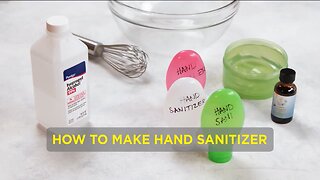Premium Only Content

How to Make Your Own Hand Sanitizer | Homemade Sanitize corona virus life Hacks 5 minutes crafts.
Preventing the spread of infectious diseases like COVID-19, nothing beats good old-fashioned hand washing.
But if water and soap aren’t available, your next best option, according to the Centers for Disease Control and Prevention (CDC), is to use an alcohol-based hand sanitizer.
Unless you have a stockpile of store-bought hand sanitizer, you’ll likely have a hard time finding any at a store or online right now. Due to the rapid spread of the novel coronavirus, most retailers can’t keep up with the demand for hand sanitizer.
The good news? All it takes is three ingredients to make your own hand sanitizer at home. Read on to find out how.
What ingredients do you need?
Making your own hand sanitizer is easy to do and only requires a few ingredients:
isopropyl or rubbing alcohol (99 percent alcohol volume)
aloe vera gel
an essential oil, such as tea tree oil or lavender oil, or you can use lemon juice instead
The key to making an effective, germ-busting hand sanitizer is to stick to a 2:1 proportion of alcohol to aloe vera. This keeps the alcohol content around 60 percent. This is the minimum amount needed to kill most germs, according to the CDC.
How do you make your own hand sanitizer?
Dr. Rishi Desai, chief medical officer of Osmosis, and a former epidemic intelligence service officer in the division of viral diseases at the CDC, says that the hand sanitizer recipe below will kill 99.9 percent of germs after 60 seconds.
Hand sanitizer recipe
What you’ll need:
3/4 cup of isopropyl or rubbing alcohol (99 percent)
1/4 cup of aloe vera gel (to help keep your hands smooth and to counteract the harshness of alcohol)
10 drops of essential oil, such as lavender oil, or you can use lemon juice instead
Directions:
Pour all ingredients into a bowl, ideally one with a pouring spout like a glass measuring container.
Mix with a spoon and then beat with a whisk to turn the sanitizer into a gel.
Pour the ingredients into an empty bottle for easy use, and label it “hand sanitizer.”
Jagdish Khubchandani, PhD, associate professor of health science at Ball State University, shared a similar formula.
His hand sanitizer formula combines:
two parts isopropyl alcohol or ethanol (91 percent to 99 percent alcohol)
one part aloe vera
a few drops of clove, eucalyptus, peppermint, or other essential oil.
If you are making hand sanitizer at home, Khubchandani says to adhere to these tips:
Make the hand sanitizer in a clean space. Wipe down counter tops with a diluted bleach solution beforehand.
Wash your hands thoroughly before making the hand sanitizer.
To mix, use a clean spoon and whisk. Wash these items thoroughly before using them.
Make sure the alcohol used for the hand sanitizer is not diluted.
Mix all the ingredients thoroughly until they are well blended.
Do not touch the mixture with your hands until it is ready for use.
For a larger batch of hand sanitizer, the World Health Organization (WHO) has a formula for a hand sanitizer that uses:
isopropyl alcohol or ethanol
hydrogen peroxide
glycerol
sterile distilled or boiled cold water
Some commercial hand sanitizer contains ingredients as scary as the germs they protect you from, so why not make your own hand sanitizer from ingredients you select? This is an excellent project for kids as well as adults since the project can be expanded to include a discussion about hygiene and disinfection. You'll save money, protect yourself from germs, and can customize the scent of the hand sanitizer so it doesn't smell medicinal.
How It Works
The active ingredient in this hand sanitizer recipe is the alcohol, which needs to comprise at least 60% of the product in order to be an effective disinfectant. The recipe calls for 99% isopropyl alcohol (rubbing alcohol) or ethanol (grain alcohol, most commonly available at 90%-95%). Please don't use any other types of alcohol (e.g., methanol, butanol), as they are toxic. Also, if you use a product that contains a lower percentage of alcohol (e.g., 70% alcohol) then you need to increase the amount of alcohol in the recipe or it won't be as effective.
Essential Oils in Hand Sanitizer
In addition to adding fragrance to your hand sanitizer, the essential oil you choose may also help protect you against germs. For example, thyme and clove oil have antimicrobial properties. If you are using antimicrobial oils, only use a drop or two, since these oils tend to be very powerful and might irritate your skin. Other oils, such as lavender or chamomile, may help soothe your skin.
-
 1:33
1:33
WPTV
4 years agoWATCH: How to make your own hand sanitizer
436 -
 20:46
20:46
KTNV
4 years agoMaking your own hand sanitizer
321K -
 1:34
1:34
CoverVideo
5 years ago $0.03 earned5 Thanksgiving Hacks to Make Your Life Easier
83 -
 1:34
1:34
CoverVideo
5 years ago $4.78 earned5 Thanksgiving Hacks to Make Your Life Easier
11.6K -
 0:20
0:20
JHoffman
4 years ago $0.08 earnedWhile corona virus
637 -
 0:31
0:31
A4lway
4 years ago $0.01 earnedCorona virus special
163 -
 0:15
0:15
Levy29
4 years ago $0.27 earnedCorona Virus part1
787 -
 1:18
1:18
KMTV
4 years agoCompanies teaming up to make hand sanitizer
9 -
 1:29
1:29
Monkeysee
4 years agoDIY Hand Sanitizer
148 -
 4:46
4:46
Noah Game Adventures
5 years agoHomemade Pizza How to Make Your Own Pizza at Home
1.26K